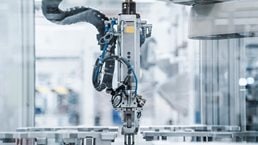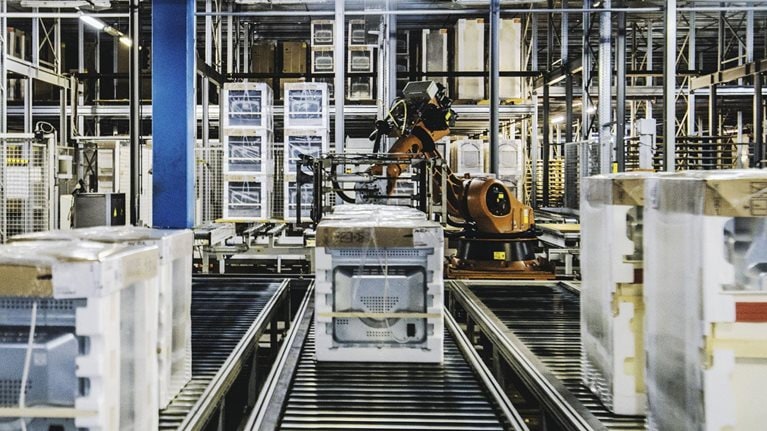Along with its severe human toll, the spread of the coronavirus has exacerbated long-standing challenges in businesses worldwide. For industrial companies—especially those with high-mix, low-volume manufacturing—COVID-19 has increased the already-widespread problems with shop-floor productivity. As supply-chain disruptions affect shipment of critical parts, industrials are struggling to meet their promised customer delivery dates. Within plants, physical-distancing requirements and line closures are disturbing some workflows. These delays often prevent industrials from delivering critical products, including sanitization tools and other equipment to help their customers both fight and recover from the pandemic.
For many years, industrials have deployed lean levers and performance-management initiatives to improve productivity and expand margins. They usually achieved good initial results, but their gains frequently vanished or decreased as managers became distracted and employees returned to their old ways. Some industrials have also offshored production to reduce costs but then encountered substantial challenges and high start-up costs when they tried to replicate their capabilities and skills in new locations. With recent tariffs and travel disruptions creating unprecedented uncertainty, more businesses are considering reshoring production to increase their resilience and flexibility in the “next normal.” That makes manufacturing performance even more important.
A new approach to productivity—active performance management (APM)—may be more likely to deliver lasting gains than previous methods. It focuses on three areas where most current solutions fall short: real-time performance visibility, daily performance planning, and end-to-end accountability. When high-mix, low-volume industrials incorporate APM into their standard workflows, they typically improve productivity by 30 to 50 percent within eight to 12 weeks of deployment while simultaneously increasing on-time deliveries and unlocking additional capacity.
Real-time performance transparency
Surprisingly, many high-mix, low-volume manufacturing operations lack real-time visibility into performance. Instead, they review key performance indicators (KPIs) weekly or even monthly. This frequency may be enough to drive performance in high-volume environments, where variability is low and processes are predictable, but it is not well suited to the complexity of a high-mix factory.
Without real-time transparency, supervisors are unlikely to discuss and address issues until their impact has snowballed. For example, one industrial appliance manufacturer with an assembly line that produced $4 million in product per month was accumulating nearly $1 million of additional backlog over the same period because it did not have robust solutions for tracking daily performance. Units would literally get lost and tucked away on a vast line, and operators would step away from their stations and attempt to resolve issues rather than flagging or escalating them. The number of partially completed units soared, customers threatened to cancel orders, and the company missed out on new business because its lead times were so high.
The APM approach takes a much more detailed view of production by breaking up each shift into two- to three-hour performance blocks (Exhibit 1). For each block, the production target is generally a proportional amount of the end-of-shift goal. (The process for setting targets is described in the sidebar, “Building a labor-content baseline”). Supervisors receive information about these blocks upon their completion, enabling a near-real-time view of performance. They can then flag problems as they occur and identify root cases immediately, before any issues escalate. Most important, they can quickly act to get a shift back on track to target. To prevent future issues, information about all problems and root cases is logged in a database, so supervisors can develop improvement initiatives and assign each one to an owner. The owners are responsible for identifying and implementing a sustainable, long-term solution over a short time frame—typically, within 24 hours.

On a weekly basis, plants can use the assembled data to conduct a more holistic analysis by looking at the largest loss drivers, identifying different improvement strategies, and selecting those that will produce the most benefit. For each strategy, improvement initiatives are developed, a clear owner is engaged, and completion progress is visibly displayed for all employees to see.
Would you like to learn more about our Advanced Electronics Practice?
Beyond generating a detailed look at each shift, the APM approach provides insights into performance at the individual-operator level. In addition to encouraging employees to strive for improvement, this information helps supervisors to flag issues—such as slowdowns resulting from missing parts or tools, quality issues requiring rework, and difficulties that arise during challenging or unfamiliar processes—that typically get lost during a shift. With the increased visibility, area leads and supervisors can give operators the help they need to achieve their targets. In turn, operators feel that supervisors support them and recognize their concerns.
Under APM, all employees, not just managers, have complete visibility into performance. Many industrial manufacturing facilities initially place simple performance boards in each production area—basically, large mounted whiteboards that are manually updated to show the actual work completed during each performance block, as well as how much it varied from the target (Exhibit 2). Eventually, most facilities that adopt APM migrate to one of several digital tools for easier updating and clear, cloud-based performance transparency, downtime tracking, and the identification and resolution of issues.

As with any tool, manufacturing plants must ensure that trained, on-site support is available, allowing it to be used consistently. The current manufacturing slowdown, in which many plants operate at reduced capacity, may be an ideal time for industrials to rethink their digital performance-tracking solutions and experiment with new ones.
When we examined the impact of real-time performance tracking across a complex line at a high-mix, low-volume industrial business, we found that productivity rose eight percentage points (Exhibit 3). While lean levers were also beneficial, they did not generate as much improvement on their own.

After this business undertook an end-to-end operational transformation that emphasized real-time performance transparency across all lines, overall productivity rose by 35 percent in 16 weeks. The business also rapidly unearthed additional opportunities to improve the supply chain, eliminate part shortages, and simplify manufacturing during product design. By pursuing these opportunities, manufacturing operations increased product throughput by 30 percent, without additional capital investment in equipment or facilities, enabling business growth.
The ‘performance envelope’ approach to daily performance planning
To achieve high performance in manufacturing, companies need a rigorous approach to production planning. At many industrials, the sales and operations-planning team sends daily targets and schedules to the shop floor, rather than providing a week- or month-long plan well in advance. Its leaders usually take this approach because they lack digital scheduling tools, underestimate the importance of planning, or are so focused on day-to-day customer needs that they have little time to think about the future.
While companies with minimal variation between products can rely on daily visibility of production needs, high-mix, low-volume industrials often encounter problems when they follow the same approach. Since their staffing requirements vary, depending on how products are customized, such companies will end up with either too many or too few employees if line assignments remain static. Supply bottlenecks—now more common because of COVID-19—may also require more frequent staffing adjustments because some lines lack the necessary inputs.
A second component of APM, the performance-envelope model, addresses these problems (Exhibit 4). It provides a comprehensive view of efficiency targets and staffing requirements, including the buffer required to account for unplanned events, such as absenteeism, part shortages, and rework. In this four-step model, supervisors first examine demand for the week ahead and the current backlog for a single production area, using customer delivery dates and required stock levels as a guide. This information is then analyzed and translated into essential output—both product type and quantity—for each production line.

After quantifying production requirements, supervisors can create a staffing plan that maps the required labor across lines. They can also apply analytics to adjust the production sequence when needed. A model might, for instance, indicate where bottlenecks are most likely to occur as the product mix changes throughout a given day or week. Staff can then be proactively reallocated across stations to balance the line. The model might also identify other efficiency-optimizing tactics, such as grouping similar units into a single production shift or flexing staffing across shifts (or even hour by hour within a given shift). The exact changes will depend on the product mix.
Supervisors then repeat this process for each production area in a plant. If conditions change—for instance, when unexpected supply problems materialize—supervisors must request a variance before deviating from the plan. The plant’s leadership will then determine whether to approve changes, by considering various factors, including production needs and the potential risks of delayed production or lower efficiency. In some cases, the leadership may ask supervisors to create a recovery plan or to provide additional support by taking various steps such as shifting underutilized capacity from other areas of the plant, permitting a small amount of overtime, or postponing production of lower priority units. The issue is then logged, and staff undertakes a rapid root-cause analysis (typically within 24 hours) and develops solutions to avoid a repeat.

Coronavirus: A response framework for advanced industries companies
End-to-end accountability
When we asked manufacturing employees at industrial companies about performance accountability, most said that it was absent or at least not a top management priority. One supervisor remarked, “we have a process, but it’s not uniformly used—there is no consistent messaging from leadership.” Another noted, “hardly ever does anyone reach out to help us improve performance, even when efficiency falls short of our goals. We stopped sending weekly productivity emails a year ago, and no one has said a thing.”
While some companies have tried to increase accountability, they usually end up delegating performance-management initiatives to business-unit heads or leaders of individual plants. Both might design programs that lack the right incentives or processes. Under APM, leaders of high-mix, low-volume industrials deploy performance-management initiatives uniformly across each manufacturing facility. Although these initiatives are designed centrally, each site’s general managers and senior leaders are accountable for deploying them and monitoring compliance.
To increase individual accountability under APM, each production employee has specific targets that feed into line- or area-specific production goals. In turn, the line and area goals are directly linked to business targets. For instance, managers might tie a line’s annual production volume to the plant’s overall rate for on-time delivery. Ideally, companies will create employee incentives based on business targets rather than line or individual targets, to eliminate conflicts of interest. As one example, a line will not hoard parts to meet its own targets if employee incentives are tied to plant-wide production.
End-to-end accountability, combined with greater performance transparency, can produce striking results. For example, one US industrial-equipment manufacturer faced eroding margins because of its decade-long challenges in capability building and coordination. These problems became worse as the business increasingly produced high-mix, low-volume products.
In response, manufacturing leadership launched an APM program and deployed a digital performance tool that provided broad transparency on individual-, line-, and plant-level performance. The leaders then compared actual results with established goals, During the first six weeks, productivity increased by more than 20 percent. The increased visibility also encouraged employees to demonstrate significantly greater ownership and accountability across all levels of the manufacturing organization.
In labor-intensive manufacturing organizations, productivity is often one of the most important levers for improving customer-service levels, growth, and profitability. That is especially true at high-mix, low-volume industrials where production needs shift constantly. At these businesses, APM can improve productivity more quickly than traditional lean approaches alone and decrease near-term costs. That is now vital with COVID-19 lowering revenues, reducing worker availability, and creating economic uncertainty. In addition, APM can help industrials rapidly unlock additional capacity at plants, without additional investment in space or equipment. Such shifts can help industrial companies get their vital products to market more quickly and emerge stronger as the pandemic abates and they transition to the next normal.


